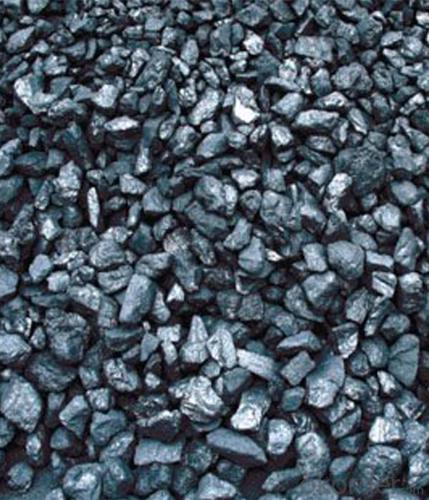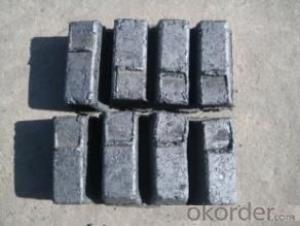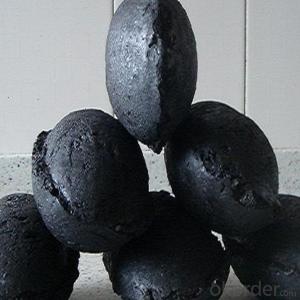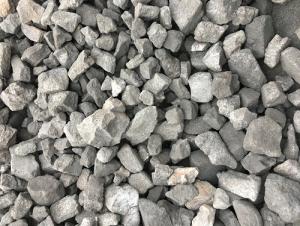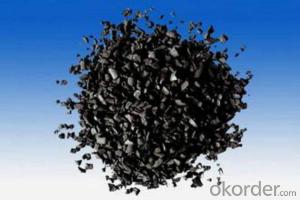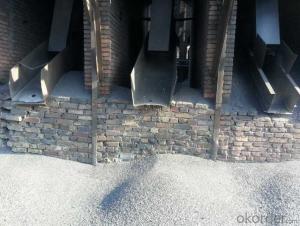Good Quality Charge Coke With Low Sulphur
- Loading Port:
- Tianjin
- Payment Terms:
- TT OR LC
- Min Order Qty:
- 20 m.t.
- Supply Capability:
- 3000 m.t./month
OKorder Service Pledge
OKorder Financial Service
You Might Also Like
Good Quality Charge Coke With Low Sulphur
Features
1. strong supply capability
2. fast transportation
3. lower and reasonable price for your reference
4.low sulphur, low ash
5.fixed carbon:95% -90%
6..sulphur:lower than 0.3%
Package
In 25KG bags or in MT bags
Product Description
Cardon additives made from well-selected Tai Xi anthracite .Mainly used in steelmaking
in electrical stove, screening water,quality,shipbuilding sandblast removing rust producingcarbon materials.Mainly industry property of it is : instead of traditional pertroleum coal of Carbon Additives,reduce the cost of steelmaking.
Specification
PARAMETER UNIT GUARANTEE VALUE
F.C.% 95MIN 94MIN 93MIN 92MIN 90MIN
ASH % 4MAX 5MAX6 MAX6.5MAX8.5MAX
V.M.% 1 MAX 1MAX1.0MAX1.5MAX 1.5MAX
SULFUR % 0.3MAX0.3MAX0.3MAX0.35MAX0.35MAX
MOISTURE %0.5MAX0.5MAX0.5MAX0.5MAX0.5MAX
Pictures:
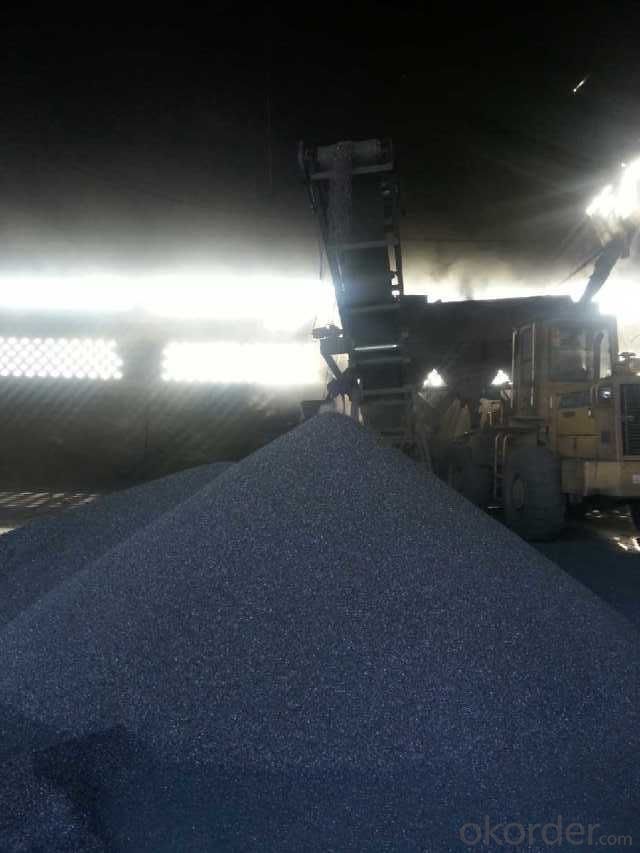
- Q: Something that seems to be used in the locomotive brake system. I haven't seen it, either. Who knows? It's better for the locomotive system to go back. Thank you!!
- The pantograph's bow head has several detachable electrically conductive strips of carbon or powder alloy used to contact the contact wire and power it from above.
- Q: What are the consequences of increased carbon emissions on technological advancements?
- The consequences of increased carbon emissions on technological advancements can be both positive and negative. On one hand, the increased focus on reducing carbon emissions has spurred innovation in clean technology and renewable energy sources. This has led to advancements in technologies such as solar panels, wind turbines, and electric vehicles, which are considered more environmentally friendly alternatives to traditional energy sources. These advancements have the potential to create new industries, generate jobs, and promote sustainable development. On the other hand, increased carbon emissions can have negative consequences on technological advancements. The rising levels of carbon dioxide in the atmosphere contribute to climate change, which poses significant challenges to various sectors, including technology. Extreme weather events, such as hurricanes and wildfires, can damage infrastructure and disrupt technological systems. In addition, higher temperatures can affect the efficiency of electronic devices, leading to increased energy consumption and reduced performance. Furthermore, the need to mitigate and adapt to climate change through the development of clean technologies requires significant financial investments. This can divert resources from other areas of technological innovation and research, limiting advancements in fields such as artificial intelligence, biotechnology, or space exploration. As a result, the focus on addressing carbon emissions may reduce the overall pace of progress in certain technological areas. Overall, the consequences of increased carbon emissions on technological advancements are complex and multifaceted. While they have driven innovation in clean technologies, they have also presented challenges and trade-offs in terms of resource allocation and the impact of climate change on technological infrastructure. Efforts to reduce carbon emissions need to be balanced with ensuring continued progress in other technological fields to achieve a sustainable and technologically advanced future.
- Q: RT~ I remember our teacher said, but I forgot all of a sudden......Ask for advice!
- Well, secondary carbon and oxygen double bonds do not add much. What is involved in high school?:1, in the nickel catalyzed conditions, with H2 addition (also a reduction, but note that in the carboxyl group -COOH carbon oxygen double bond can not be added by the general method plus H)2, aldehyde addition (aldol condensation). The college entrance examination had many times, is simply an aldehyde -CHO under certain conditions and containing active H group reaction R-H (commonly known as alpha H that -H doesn't have to be in the next -CHO H, like -COOH, phenyl can also, but to see more in the next -CHO generation of C- (OH) -R). The H is added to the O, and the alkyl R- is added to the C.For example: CH3-CHO+HCHO==CH3-C (OH) -CHO (called 2- 3-hydroxypropanal)There are some universities, the mechanism involved is more complex, you want to HI me
- Q: What are the properties of carbon fibers?
- Carbon fibers possess a range of remarkable attributes, rendering them a distinctive and adaptable material. One noteworthy characteristic is their exceptional strength-to-weight ratio. Carbon fibers exhibit tremendous strength, often surpassing that of steel, while also being significantly lighter. This quality makes them exceptionally well-suited for industries such as aerospace and automotive, where high strength and low weight are essential. Another significant attribute of carbon fibers is their stiffness. They possess a high degree of rigidity, ensuring minimal deformation when subjected to applied loads. This property proves advantageous in applications that require stability and rigidity, such as the construction of sporting goods like tennis rackets or golf clubs. Additionally, carbon fibers display outstanding resistance to chemical corrosion. They exhibit a high level of resistance to the detrimental effects of chemicals or corrosive substances, making them highly suitable for use in harsh environments. Industries such as chemistry or offshore structures prefer carbon fibers due to this property. Furthermore, carbon fibers have a low thermal expansion coefficient, indicating minimal expansion when exposed to heat. This characteristic is vital in applications where thermal stability is crucial, such as the manufacturing of high-temperature components like turbine blades or heat shields. Moreover, carbon fibers possess excellent fatigue resistance, enabling them to endure repeated loading and unloading cycles without significant damage. This attribute is particularly advantageous in applications subjected to cyclic or dynamic stresses, including the construction of sports equipment or aerospace structures. Lastly, carbon fibers exhibit excellent electrical conductivity. They efficiently conduct electricity, making them suitable for applications that require electrical conductivity, such as lightning strike protection in the aerospace industry or the production of electronic devices. In summary, the high strength-to-weight ratio, stiffness, chemical resistance, low thermal expansion, fatigue resistance, and electrical conductivity of carbon fibers establish them as a highly sought-after material in various industries.
- Q: How does carbon impact soil health?
- Carbon is essential for maintaining soil health as it acts as a key component of organic matter. It helps improve soil structure, water holding capacity, and nutrient availability, thereby promoting the growth of beneficial soil microorganisms and enhancing overall soil fertility.
- Q: How does carbon impact the prevalence of droughts?
- Carbon, specifically in the form of carbon dioxide (CO2) emissions, plays a significant role in the prevalence of droughts. The increase in carbon levels in the atmosphere contributes to global warming, which in turn affects the overall climate patterns worldwide. When carbon dioxide is released into the atmosphere through human activities such as burning fossil fuels and deforestation, it acts as a greenhouse gas. Greenhouse gases trap heat from the sun and prevent it from escaping back into space, causing the Earth's temperature to rise. As the global temperature increases, it leads to changes in precipitation patterns and evaporation rates. Warmer temperatures accelerate evaporation, causing more water to evaporate from lakes, rivers, and soil. This increased evaporation coupled with altered precipitation patterns results in drier conditions and reduced water availability in certain regions. Additionally, the rising temperatures contribute to the intensification of the water cycle, causing more extreme weather events. This includes more frequent and severe droughts, as well as intense rainfall in some areas, leading to increased risks of floods. Furthermore, carbon emissions also contribute to changes in atmospheric circulation patterns, such as the weakening of the jet stream. The jet stream is responsible for steering weather systems, including rain-bearing weather fronts, across the globe. When it weakens, weather systems tend to become stagnant, resulting in prolonged periods of drought in certain regions. Overall, the increased levels of carbon in the atmosphere due to human activities have a direct impact on global warming and climate change. These changes in climate patterns and atmospheric circulation, combined with the intensification of the water cycle, significantly influence the prevalence and severity of droughts worldwide. Therefore, reducing carbon emissions and mitigating climate change is crucial in addressing and minimizing the impacts of droughts on ecosystems, agriculture, and human populations.
- Q: Why is the longer the carbon chain, the better the hydrophobic properties?
- The carbon chain is the water chain, but the lower the polarity (TA)They have to write fifteen characters ah from702853 (station link TA) can theoretically explain it zhoupeng87 (station link TA) should be the basic alkyl is not hydrophilic, it belongs to the hydrophobic group, the increase of carbon chain length of the hydrophobic whyy0113 (station TA) carbon chain is longer, the more polar groups easily entrapped nature shows hydrophobic alkane name small Jia (TA station) the carbon chain length of hydrophobic chain length, of course, hydrophobic. Cher (station TA) the alkyl chain is hydrophobic, so the longer hydrophobic part content more hydrophobic natural good red sandalwood fragrance (TA station).
- Q: How does carbon impact the stability of savannah ecosystems?
- The stability of savannah ecosystems relies heavily on carbon, which is crucial for all living organisms and involved in various ecological processes. Carbon exists primarily in the form of organic matter, which is vital for the growth and development of plants, the primary producers in these ecosystems. In savannahs, carbon affects stability in multiple ways. Firstly, carbon dioxide (CO2) plays a significant role in regulating the global climate as a key component of the Earth's atmosphere. Savannahs have the ability to sequester and store large amounts of carbon in their vegetation and soils, thereby mitigating climate change by reducing CO2 levels in the atmosphere. Carbon is also essential for plant growth through photosynthesis. Savannah plants, like grasses and scattered trees, utilize carbon dioxide from the air to produce carbohydrates and other organic compounds. This process not only provides plants with energy but also contributes to the overall productivity of the ecosystem. The stability of savannah ecosystems is also dependent on the interaction between plants and animals. Carbon-rich vegetation serves as a food source for herbivores, which in turn support predators. The carbon cycle ensures a continuous flow of energy and nutrients throughout the food web, maintaining ecosystem balance and stability. Moreover, the carbon content in savannah soils affects their fertility and ability to retain moisture. Organic matter derived from decaying plant material improves soil structure, nutrient availability, and water holding capacity. This, in turn, supports vegetation growth and sustains the diverse array of species found in savannah ecosystems. However, human activities such as deforestation, agricultural practices, and the burning of fossil fuels are disrupting the carbon balance in savannahs. Deforestation removes carbon-rich trees and plants, reducing the overall carbon storage capacity of the ecosystem. Additionally, the release of carbon dioxide from burning fossil fuels contributes to the greenhouse effect and climate change, which can disrupt savannah ecosystem stability. In conclusion, carbon plays a critical role in maintaining the stability of savannah ecosystems. It influences climate regulation, supports plant growth, provides energy for the food web, and enhances soil fertility. However, human activities that disrupt the carbon balance in these ecosystems can have detrimental effects on their stability and overall health. Therefore, it is essential to conserve and restore savannah ecosystems to preserve their carbon storage capacity and ensure long-term stability.
- Q: Consult the carbon content of austenite
- Pure iron carbon alloys, austenitic (A) carbon content in different grades, different temperature and different, in more than 727 degrees (727 degrees when the carbon content is 0.77%), 1148 degrees, 2.11% carbon content with see iron carbon phase diagram
- Q: How is carbon used in the production of construction materials?
- Carbon is used in the production of construction materials in several ways. One of the most common applications is in the production of steel, which is a vital material in the construction industry. Carbon is a key component in the iron and steel-making process, as it is combined with iron to create a stronger and more durable material. The addition of carbon to iron forms a compound known as steel, which has excellent structural properties and can be used to construct various components of buildings, such as beams, columns, and reinforcement bars. Additionally, carbon fibers are increasingly being used in the production of construction materials. Carbon fibers are lightweight, yet incredibly strong and stiff, making them ideal for reinforcing concrete and other materials. When carbon fibers are added to concrete, they enhance its strength and durability by reducing cracking and improving its resistance to impact and corrosion. This allows for the construction of structures that are more resilient and longer-lasting. Furthermore, carbon is used in the production of composite materials, which are becoming popular in construction. Carbon composites are made by combining carbon fibers with a polymer matrix, resulting in a material that is lightweight, yet strong and rigid. These composites are used in various construction applications, such as building panels, roofing, and bridges, as they offer high strength-to-weight ratios and excellent resistance to environmental factors. In summary, carbon plays a crucial role in the production of construction materials. It is used in the creation of steel, which is a fundamental component of buildings, and its fibers are employed to reinforce concrete and other materials. Additionally, carbon composites provide lightweight and high-strength solutions for construction applications. By harnessing the properties of carbon, construction materials can be made stronger, more durable, and more sustainable.
Send your message to us
Good Quality Charge Coke With Low Sulphur
- Loading Port:
- Tianjin
- Payment Terms:
- TT OR LC
- Min Order Qty:
- 20 m.t.
- Supply Capability:
- 3000 m.t./month
OKorder Service Pledge
OKorder Financial Service
Similar products
Hot products
Hot Searches


